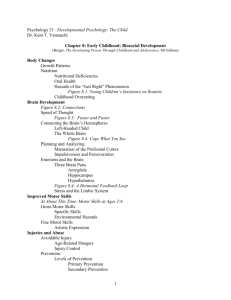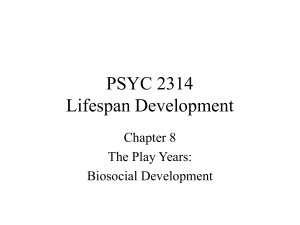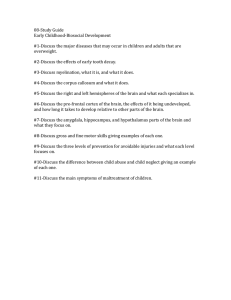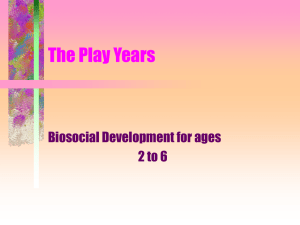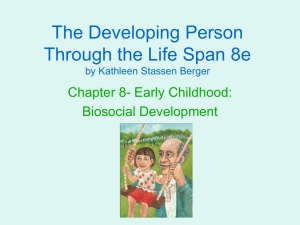The potential for cost savings from home visiting due to reductions in
advertisement
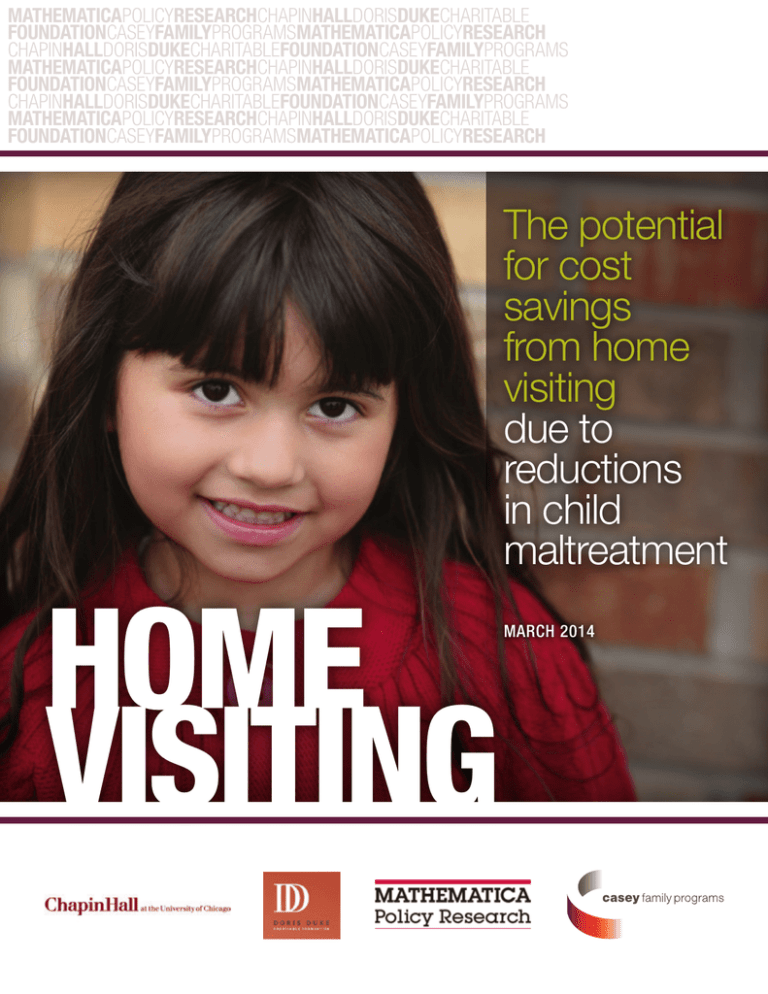
MATHEMATICAPOLICYRESEARCHCHAPINHALLDORISDUKECHARITABLE FOUNDATIONCASEYFAMILYPROGRAMSMATHEMATICAPOLICYRESEARCH CHAPINHALLDORISDUKECHARITABLEFOUNDATIONCASEYFAMILYPROGRAMS MATHEMATICAPOLICYRESEARCHCHAPINHALLDORISDUKECHARITABLE FOUNDATIONCASEYFAMILYPROGRAMSMATHEMATICAPOLICYRESEARCH CHAPINHALLDORISDUKECHARITABLEFOUNDATIONCASEYFAMILYPROGRAMS MATHEMATICAPOLICYRESEARCHCHAPINHALLDORISDUKECHARITABLE FOUNDATIONCASEYFAMILYPROGRAMSMATHEMATICAPOLICYRESEARCH HOME VISITING The potential for cost savings from home visiting due to reductions in child maltreatment MARCH 2014 Authored by: Heather Zaveri and Andrew Burwick | Erin Maher | CASEY FAMILY PROGRAMS MATHEMATICA POLICY RESEARCH casey family programs | casey.org Average lifetime cost per death resulting from child $1.5 maltreatment million $1,272,900 The maltreatment of children imposes a high cost on both victims and society at large. In fiscal year 2012, child protective services (CPS) agencies received 3.4 million allegations of maltreatment involving 6.3 million children. An estimated 686,000 children were victims of substantiated maltreatment.1 These children are more likely than their peers to experience emotional and behavioral problems, substance abuse, chronic health conditions, juvenile delinquency, adult criminal involvement, lost productivity, and diminished potential.2 Besides the enormous physical, mental, and emotional harms of child abuse, there are economic costs. According to one estimate, the average lifetime cost per victim of nonfatal child maltreatment is $210,012 in 2010 dollars. This estimate includes costs to both society and the victim for short- and long-term health care, productivity losses, child welfare services, criminal justice services, and special education. The authors also estimated that the average lifetime cost per death resulting from child maltreatment is $1,272,900.3 Average lifetime cost per Home-visiting programs offer one method for delivering support services to at-risk families and children and for possibly improving a range of outcomes related to child development, child and maternal health, parenting practices, family economic self-sufficiency, and other areas. Emerging evidence indicates that some program models may specifically help to prevent maltreatment. Such an outcome would be desirable from any standpoint; from an economic perspective, the long-term benefits of such models may outweigh the short-term program costs, given the high estimated costs of child maltreatment. $210,012 In this brief, we describe the evidence of effectiveness of several home-visiting program models in reducing child maltreatment. We present the estimated costs of implementing these models and describe the additional information needed to assess whether they are cost-beneficial with respect to reductions child maltreatment and other outcomes. victim of nonfatal child maltreatment $0 Source: Fang, X., D. S. Brown, C. S. Florence, and J. A. Mercy. “The Economic Burden of Child Maltreatment in the United States and Implications for Prevention.” Child Abuse and Neglect, vol. 36, 2012, pp. 156–65. The brief focuses on four program models—Healthy Families America (HFA), Nurse Family Partnership (NFP), Parents as Teachers (PAT), and SafeCare. Agencies implementing these models were part of a recent study of home-visiting costs conducted by Mathematica Policy Research and Chapin Hall at the University of Chicago, with support from the Doris Duke Charitable Foundation and in partnership with Casey Family Programs. The potential for cost savings from home visiting due to reductions in child maltreatment Can Home Visiting Reduce Child Maltreatment? The federal government is sponsoring an ongoing review of the research literature to assess the evidence of effectiveness of home-visiting program models. Mathematica conducts the Home Visiting Evidence of Effectiveness (HomVEE) review for the U.S. Department of Health and Human Services (DHHS).a As of 2013, the review identified 14 home-visiting program models that meet criteria established by DHHS for an “evidence-based model” of home-visiting services for families with young children.4 The HomVEE review involves assessing the research evidence related to program outcomes, including reductions in child maltreatment. Impact studies included in the review use a randomized controlled trial or quasi-experimental design. The studies that met review criteria and examined child maltreatment relied on two primary outcome measures of maltreatment: (1) evidence of substantiated child maltreatment based on administrative records and (2) counts of encounters with health care providers that may occur as a result of maltreatment, such as treatment of children for injuries or ingestions, based on medical records. These studies also used two secondary outcome measures: (1) parent reports of neglectful, aggressive, or abusive behavior based on the Conflict Tactics Scale for Parent and Child, which is used to measure maltreatment and neglect, and (2) parent reports of encounters with health care providers. The review identified evidence that some home-visiting programs reduced child maltreatment. Of the four models considered here, NFP has the highest number of favorable findings related to reducing child maltreatment. HomVEE identified seven favorable impacts on the primary maltreatment measures for NFP and one favorable impact on the primary measures for each of the other three a Details regarding the HomVEE review process and the criteria for designating a model as “evidence based” are available at www.homvee.acf.hhs.gov. 4 | casey family programs HOME VISITING models (Table 1). The HomVEE review also found favorable impacts on 14 of the secondary measures for HFA and on one secondary measure for SafeCare Augmented (an adaptation of SafeCare that trains home visitors in motivational interviewing and in identifying and responding to imminent child maltreatment). Studies of each program model showed no impacts for some of the measured maltreatment outcomes, but no unfavorable or ambiguous maltreatment impacts were identified at the time of the review.b TA B L E O N E NUMBER OF IMPACTS Number of Impacts on Outcome Measures Related to Reductions in Child Maltreatment for Selected Home Visiting Program Models, as Identified by the Home Visiting Evidence of Effectiveness Review Favorable Impacts Sustained at Least One Year after Program Completion Number of Primary or Secondary Outcomes with No Impacts Any Unfavorable or Ambiguous Impacts on Primary or Secondary Outcomes Number of Studies Included in Review of Impacts Number of Favorable Impacts on Primary Outcomes Number of Favorable Impacts on Secondary Outcomes Favorable Impacts Replicated in at Least Two Study Samples Healthy Families America 19 1 14 Yes Yes 142 No Nurse Family Partnership 21 7 0 Yes Yes 19 No Parents as Teachers 5 1 0 No No 2 No SafeCare 1 1 1 No Yes 10 No HomeVisiting Program Model Augmented Sources: Avellar, S., D. Paulsell, E. Sama-Miller, and P. Del Grosso, 2013. “Home Visiting Evidence of Effectiveness Review: Executive Summary.” Washington, DC: Office of Planning, Research and Evaluation, Administration for Children and Families; U.S. Department of Health and Human Services. “Home Visiting Evidence of Effectiveness.” n.d. Available at [http://homvee.acf.hhs.gov/]. Accessed December 19, 2013. b HomVEE classifies a statistically significant positive or negative impact on an outcome measure unfavorable if the direction of the impact indicates potential harm to a child or parent. An impact is defined as ambiguous if it is unclear which direction is desirable. casey family programs | 5 The potential for cost savings from home visiting due to reductions in child maltreatment The Cost of Home-Visiting Programs In their study of the costs of home-visiting programs, Mathematica and Chapin Hall adopted a standard approach and common time frame to analyze costs among 25 agencies participating in the Supporting Evidence-Based Home-Visiting (EBHV) Initiative, funded by the Children’s Bureau in the U.S. Department of Health and Human Services.5 In this approach, the estimates of costs per family were based on two figures: implementing agencies’ total annual program costs (including the value of donated or in-kind services and overhead costs) and the average length of time families were served by each agency. On average, the 18 agencies that implemented HFA, NFP, PAT, and SafeCare enrolled a family for 45 weeks and spent $6,554 serving each family (Table 2).c Across these agencies, costs per family ranged from $2,122 to $13,962. NFP agencies had higher-than-average costs per participant, which may be related to the salaries paid to home visitors in these programs. (NFP is the only program model requiring home visitors to have a bachelor’s degree in nursing, and these staff tended to have higher salaries than the direct-service staff in other agencies.) In contrast, the average cost per family was lower than average for the two agencies implementing PAT. Indeed, although PAT is designed to be a longer-term, intensive program model, the costs per family were lowest for the two PAT agencies in this study. In both agencies, the number of families served and the number exiting during the cost study period were above the overall average, reflecting high demand for services in the communities that these agencies served. On average, the 18 agencies that implemented HFA, NFP, PAT, or SafeCare enrolled a family for 45 weeks and spent $6,554 serving each family (Table 2). Among these agencies, costs per family ranged from a minimum of $2,122 to a maximum of $13,962. The study also included one agency implementing the Triple P program model, but HomVEE does not currently designate this model “evidence based.” c 6 | casey family programs TA B L E T W O ESTIMATED COST PER FAMILY Estimated Cost Per Family for Programs Implemented by Agencies Participating in the Supporting Evidence-Based Home Visiting Initiative HOME VISITING PROGRAM MODELS HEALTHY FAMILIES AMERICA NURSE FAMILY PARTNERSHIP PARENTS AS TEACHERS SAFECARE* Number of Agencies in the Study 4 10 2 2 Average Duration of Participation (weeks) | OVERALL AVERAGE 45 JAN. FEB. MAR. JAN. FEB. MAR. JAN. FEB. MAR. JAN. FEB. MAR. APR. MAY JUNE APR. MAY JUNE APR. MAY JUNE APR. MAY JUNE JULY AUG. SEPT. JULY AUG. SEPT. JULY AUG. SEPT. JULY AUG. SEPT. OCT. NOV. DEC. OCT. NOV. DEC. OCT. NOV. DEC. OCT. NOV. DEC. + 3 WEEKS 33 WEEKS 55 WEEKS 36 WEEKS 32 WEEKS Calendar depiction in graphic is only a visual representation of number of weeks and does not suggest actual time participation began and ended Average Cost Per Exiting Family | OVERALL AVERAGE $6,554 10k 10k 5,615 0 $ $ $ 8,003 $ 10k 10k $ $ 2,372 $ $ 0 $ 6,263 $ 0 $ 0 $ Range in Average Cost Per Exiting Family | OVERALL RANGE $2,122-$13,962 0 15k $ $ $ 2,848 10,502 $ 0 15k $ $ 4,228 $ 13,692 $ 0 $ 2,122 $2,622 $ 15k $ 0 15k $ $ 5,826 $6,699 $ Source: Cost Study of EBHV Programs Survey of Implementing Agencies and EBHV Cross-Site Fidelity Data. Note: Includes agencies with more than 10 families exiting the program during the cost study period (July 1, 2011 – June 30, 2012). Averages pertain to the agency level. * One of the two agencies included in the analysis provided SafeCare Augmented to address risks of intimate partner violence, substance abuse, and depression with motivational interviewing, safety planning, and problem solving casey family programs | 7 The potential for cost savings from home visiting due to reductions in child maltreatment Possible Cost Savings from Reducing Child Maltreatment Although families served by home-visiting programs generally are at risk of poor outcomes, children in only a very small proportion of these families may actually experience maltreatment. A program’s impact on child maltreatment for the average family may therefore be modest. Given the high estimated cost of child maltreatment, however, it is possible that the benefits to society of reducing maltreatment and improving other outcomes could exceed the average home-visiting program costs per family if programs demonstrate even modest reductions in child maltreatment. Studies have found that the benefits exceed the costs of at least two of the program models examined for this brief. A recent analysis of the estimated costs of NFP programs in six states, as well as a review of 30 studies of program impacts,6 found that NFP’s benefits to society were greater than the costs when considering a host of outcomes related to maternal and child well-being and health, crime, and to child maltreatment specifically. The author also found that the estimated benefits from reducing child maltreatment alone exceeded the program costs. In addition, a randomized controlled trial of an HFA program in New York State found that the government savings from the program were greater than the program’s costs for one subgroup: women who had a substantiated CPS report before they entered the program.7 These savings were a result of reduced involvement in the child welfare system and other government programs. For the full study sample, however, the program’s benefits did not appear to exceed the costs to the government. Emerging evidence on home-visiting indicates that some program models may help to prevent maltreatment. Such an outcome would be desirable from any standpoint; from an economic perspective, the long-term benefits of such models may outweigh the short-term program costs, given the high estimated costs of child maltreatment. 8 | casey family programs HOME VISITING Looking Ahead The costs of home-visiting program models need to be better understood, as does the value of the possible benefits they offer by reducing maltreatment of children and improving other outcomes. To determine whether home-visiting programs are cost-beneficial, researchers must (1) analyze information on the size of the program impacts on family outcomes, including child maltreatment prevention; (2) estimate the monetary value of these impacts to individuals and governments; and (3) compare these benefits to estimates of program costs per family. Ideally, this research will draw estimates of both costs and benefits from the same evaluation, given that outcomes and costs may vary depending on how programs are implemented, and will cover a time period long enough to capture program impacts that may occur well after a family leaves a program. Researchers looking at the costs and benefits of home-visiting programs should also examine how the context for program models and implementation affects these costs and benefits. The context includes the characteristics of families served, staff training and skills, local service infrastructure, societal norms, adherence to model standards, and successful engagement and retention of participating families; these and similar factors may influence whether a program achieves its intended results.8,9,10 The costs may also differ depending on the circumstances of local implementation. Conducting several studies of the effectiveness and costs of each model will help illuminate whether the same program model produces different outcomes and incurs different costs depending on where and how it is implemented. casey family programs | 9 References 1. U.S. Department of Health and Human Services. Child Maltreatment 2012. Washington, DC: Administration for Children and Families, Administration on Children, Youth and Families, Children’s Bureau, 2013. Available at http://www.acf.hhs.gov/sites/default/files/cb/cm2012.pdf. Accessed January 30, 2014. 2. Child Welfare Information Gateway. Long-term Consequences of Child Abuse and Neglect. Washington, DC: U.S. Department of Health and Human Services, Administration for Children and Families, Children’s Bureau, 2013. 3. Fang, X., D. S. Brown, C. S. Florence, and J. A. Mercy. “The Economic Burden of Child Maltreatment in the United States and Implications for Prevention.” Child Abuse and Neglect, vol. 36, 2012, pp. 156–65. 4. Avellar, S., D. Paulsell, E. Sama-Miller, and P. Del Grosso. “Home Visiting Evidence of Effectiveness Review: Executive Summary.” Washington, DC: Office of Planning, Research and Evaluation, Administration for Children and Families, U.S. Department of Health and Human Services, 2013. 5. Burwick, Andrew, Heather Zaveri, Lisa Shang, Kimberly Boller, Deborah Daro, and Debra A. Strong. “Costs of Early Childhood Home Visiting: An Analysis of Programs Implemented in the Supporting Evidence-Based Home Visiting to Prevent Child Maltreatment Initiative.” Princeton, NJ: Mathematica Policy Research, Inc., 2014. 6. Miller, T. R. “Nurse-Family Partnership Home Visitation: Cost, Outcomes, and Return on Investment.” Beltsville, MD: HBSA, Inc., January 2013. 7. Dumont, Kimberly, Kristen Kirkland, Susan Mitchell-Herzfeld, Susan Erhard-Dietzel, Monica Rodriguez, Eunju Lee, China Layne, and Rose Greene. “Final Report: A Randomized Trial of Healthy Families New York (HFNY): Does Home Visiting Prevent Child Maltreatment?” Rensselaer, NY: New York State Office of Children and Family Services, October 2010. 8. Matone, M., Curtis, C., Chesnokova, A., Yun, K., Kreider, A., Curtis, M., and Rubin, D. “Evaluation of Maternal and Child Home Visitation Programs: Lessons from Pennsylvania.” Philadelphia, PA: PolicyLab Center to Bridge Research, Practice and Policy, The Children’s Hospital of Philadelphia Research Institute, 2013. 9. Corwin, Tyler. “Strategies to Increase Birth Parent Engagement, Partnership, and Leadership in the Child Welfare System.” Seattle, WA: Casey Family Programs, 2012. 10. Fixsen, D. L., S. F. Naoom, K. A. Blase, R. M. Friedman, and F. Wallace. “Implementation Research: A Synthesis of the Literature.” FMHI Publication #231. Tampa, FL: University of South Florida, Louis de la Parte Florida Mental Health Institute, National Implementation Research Network, 2005. casey family programs | casey.org MATHEMATICAPOLICYRESEARCHCHAPINHALLDORISDUKECHARITABLE FOUNDATIONCASEYFAMILYPROGRAMSMATHEMATICAPOLICYRESEARCH CHAPINHALLDORISDUKECHARITABLEFOUNDATIONCASEYFAMILYPROGRAMS MATHEMATICAPOLICYRESEARCHCHAPINHALLDORISDUKECHARITABLE FOUNDATIONCASEYFAMILYPROGRAMSMATHEMATICAPOLICYRESEARCH CHAPINHALLDORISDUKECHARITABLEFOUNDATIONCASEYFAMILYPROGRAMS MATHEMATICAPOLICYRESEARCHCHAPINHALLDORISDUKECHARITABLE FOUNDATIONCASEYFAMILYPROGRAMSMATHEMATICAPOLICYRESEARCH CHAPINHALLDORISDUKECHARITABLEFOUNDATIONCASEYFAMILYPROGRAMS MATHEMATICAPOLICYRESEARCHCHAPINHALLDORISDUKECHARITABLE FOUNDATIONCASEYFAMILYPROGRAMSMATHEMATICAPOLICYRESEARCHCHAPIN HALLDORISDUKECHARITABLEFOUNDATIONCASEYFAMILYPROGRAMS MATHEMATICAPOLICYRESEARCHCHAPINHALLDORISDUKECHARITABLE FOUNDATIONCASEYFAMILYPROGRAMSMATHEMATICAPOLICYRESEARCH CHAPINHALLDORISDUKECHARITABLEFOUNDATIONCASEYFAMILYPROGRAMS MATHEMATICAPOLICYRESEARCHCHAPINHALLDORISDUKECHARITABLE FOUNDATIONCASEYFAMILYPROGRAMSMATHEMATICAPOLICYRESEARCH CHAPINHALLDORISDUKECHARITABLEFOUNDATIONCASEYFAMILYPROGRAMS MATHEMATICAPOLICYRESEARCHCHAPINHALLDORISDUKECHARITABLE FOUNDATIONCASEYFAMILYPROGRAMSMATHEMATICAPOLICYRESEARCH CHAPINHALLDORISDUKECHARITABLEFOUNDATIONCASEYFAMILYPROGRAMS MATHEMATICAPOLICYRESEARCHCHAPINHALLDORISDUKECHARITABLE FOUNDATIONCASEYFAMILYPROGRAMSMATHEMATICAPOLICYRESEARCHCHAPIN HALLDORISDUKECHARITABLEFOUNDATIONCASEYFAMILYPROGRAMS MATHEMATICAPOLICYRESEARCHCHAPINHALLDORISDUKECHARITABLE FOUNDATIONCASEYFAMILYPROGRAMSMATHEMATICAPOLICYRESEARCH CHAPINHALLDORISDUKECHARITABLEFOUNDATIONCASEYFAMILYPROGRAMS Mathematica Policy Research POLICYRESEARCHCHAPINHALLDORISDUKECHARITABLE Mathematica Policy Research seeksMATHEMATICA to improve public well-being FOUNDATION CASEY FAMILYPROGRAMSMATHEMATICAPOLICYRESEARCH by conducting studies and assisting clients with program evaluation and policy research, survey design andHALL data collection, research CHAPIN DORISDUKE CHARITABLEFOUNDATIONCASEYFAMILYPROGRAMS assessment and interpretation and program performance/data MATHEMATICA POLICYRESEARCHCHAPINHALLDORISDUKECHARITABLE management. FOUNDATIONCASEYFAMILYPROGRAMSMATHEMATICAPOLICYRESEARCH CHAPINHALLDORISDUKECHARITABLEFOUNDATIONCASEYFAMILYPROGRAMS MATHEMATICAPOLICYRESEARCHCHAPINHALLDORISDUKECHARITABLE Casey Family Programs CASEY FAMILY PROGRAMSMATHEMATICAPOLICYRESEARCHCHAPIN Casey Family ProgramsFOUNDATION is the nation’s largest operating foundation focused entirely on foster care and improving child DUKE welfare CHARITABLEFOUNDATIONCASEYFAMILYPROGRAMS HALLthe DORIS system. Founded in 1966, we work MATHEMATICA to provide and improve – and RESEARCHCHAPINHALLDORISDUKECHARITABLE POLICY ultimately prevent the need for – FOUNDATION foster care in the United States. CASEY FAMILYPROGRAMSMATHEMATICAPOLICYRESEARCH CHAPINHALLDORISDUKECHARITABLEFOUNDATIONCASEYFAMILYPROGRAMS P800.228.3559 MATHEMATICAPOLICYRESEARCHCHAPINHALLDORISDUKECHARITABLE P206.282.7300 FOUNDATIONCASEYFAMILYPROGRAMSMATHEMATICAPOLICYRESEARCH CHAPINHALLDORISDUKECHARITABLEFOUNDATIONCASEYFAMILYPROGRAMS F206.282.3555 MATHEMATICAPOLICYRESEARCHCHAPINHALLDORISDUKECHARITABLE FOUNDATIONCASEYFAMILYPROGRAMSMATHEMATICAPOLICYRESEARCH casey.org | contactus@casey.org CHAPINHALLDORISDUKECHARITABLEFOUNDATIONCASEYFAMILYPROGRAMS MATHEMATICAPOLICYRESEARCHCHAPINHALLDORISDUKECHARITABLE follow us | twitter.com/CaseyPrograms like us | facebook.com/Casey.Family.Programs

